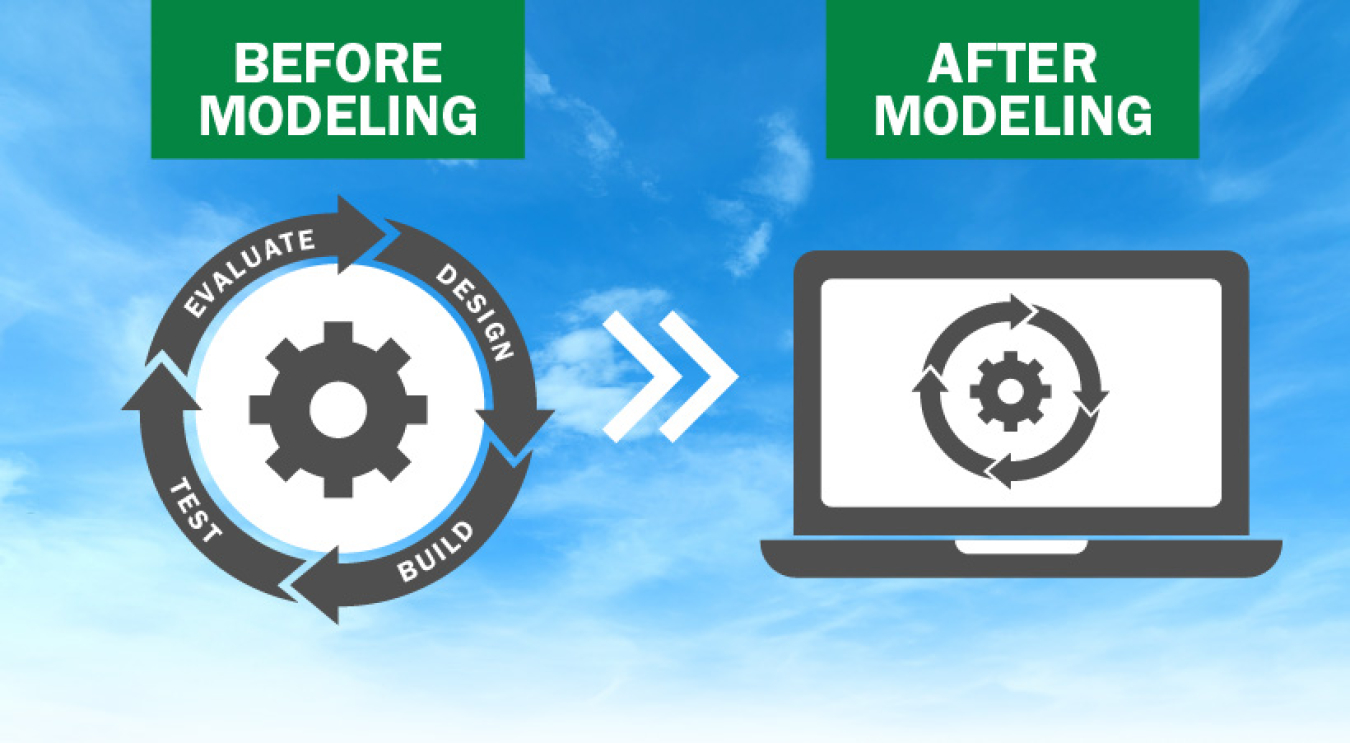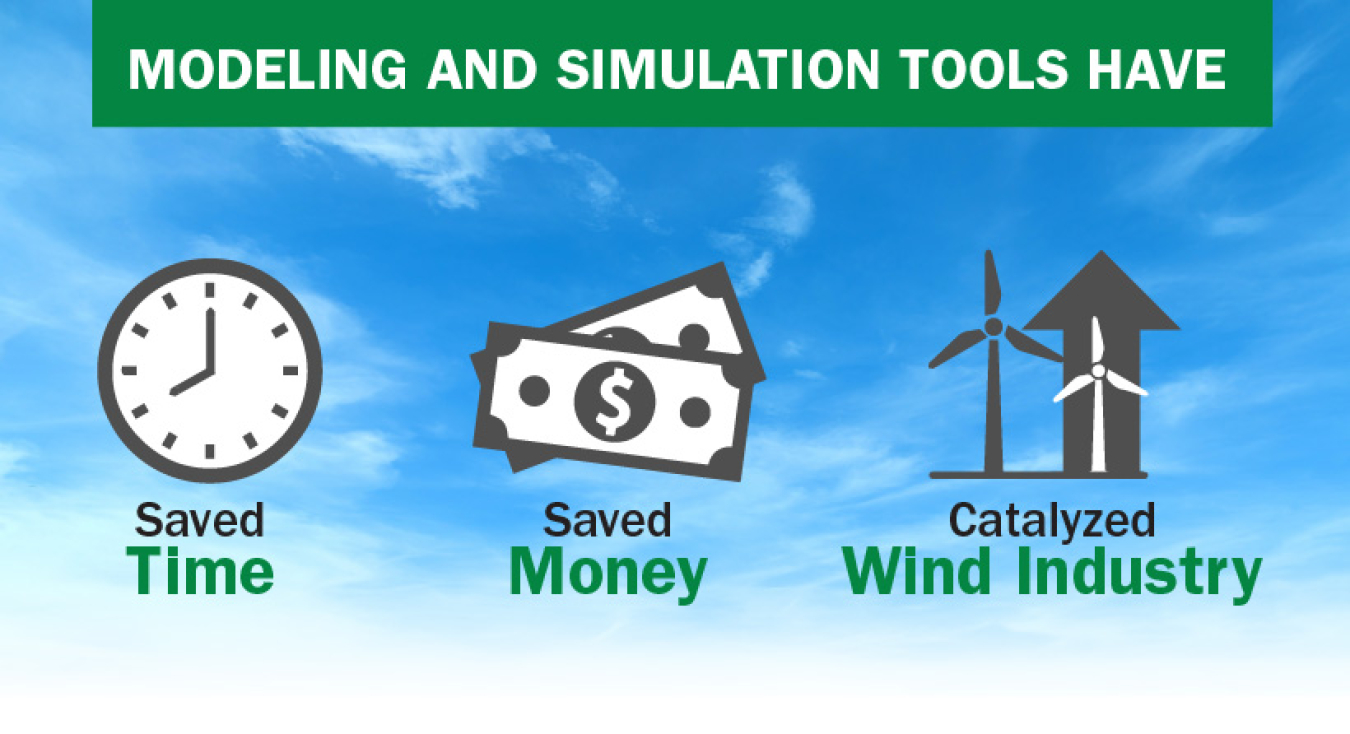WETO's decades-long support of modeling software helps expand wind energy industry's turbine design capabilities
Wind Energy Technologies Office
September 21, 2023Before computers and simulation software existed (i.e., until the mid-1980s), wind turbine manufacturers had to design and build prototypes of wind turbines in order to test and evaluate them, which was costly and time-consuming.
This four-step cycle had to be repeated several times with prototypes before the final wind turbine could be built and installed to produce electricity safely and efficiently.
Then came the computer and, eventually, modeling tools that enabled much of the process to be carried out using a simulation rather than actual construction and evaluation of a physical wind turbine.

The U.S. Department of Energy’s (DOE) Wind Energy Technologies Office (WETO) invested in modeling and simulation tools over multiple decades of funding to universities, national laboratories, and industry. These simulation tools have saved both time and money—and helped catalyze the modern international wind energy industry.
From FLAP to FAST
In the 1980s, with support from WETO, wind engineers at Oregon State University (OSU) developed software to analyze wind turbines and blades. They called it FLAP, for Force and Loads Analysis Program, to predict the loading—or forces applied—to the wind turbine blades and their response during operation. In the 1980s and 1990s, wind engineers at DOE’s National Renewable Energy Laboratory (NREL, then Solar Energy Research Institute) expanded and improved FLAP’s capabilities. By the late 1990s, NREL built on the success of FLAP by developing a new program, FAST—Fatigue, Aerodynamics, Structures, and Turbulence—which became and remains WETO’s primary wind turbine modeling software.
In 2005, FAST, which is publicly available and open source, was officially certified by Germanischer Lloyd (now part of DNV), an internationally accredited society. Industry certification provided confidence to FAST users—or potential users—that the software’s capabilities and accuracy were suitable for calculating wind turbine structural loads for design and certification. With the added credibility of certification, FAST usage grew rapidly.
WETO Continues to Invest in FAST
DOE continues to invest in FAST (now called OpenFAST) as NREL researchers improve its capabilities.
In the 2000s, recognizing that much of the country’s offshore wind potential exists in deep-water locations that require floating platforms, researchers added hydrodynamic (the force water applies on an object) and floating platform simulations to FAST. Support was also added for distributed wind turbines and direct connections linked FAST to popular industry software such as Adams by MSC, Simulink by Mathworks, and Labview. Lastly, additional applications were added to FAST that allowed for measurements of the aerodynamic characteristics of wind turbine blades.
In the early 2010s, the number of lines of source code had increased in size and complexity, which led to a new code framework to continue supporting its expansion.
With the new framework, new functions like BeamDyn, a FAST module that simulates complex blade builds; and SubDyn, and a FAST module that simulates multimember support structures. Other capabilities that were added to FAST include simulating wake and array effects with FAST.Farm and coupling to computational fluid dynamics models (such as Simulator for Wind Farm Applications [SOWFA] or ExaWind). These improvements resulted in FAST’s comprehensive modeling and simulation approach to wind turbine design.

Lasting Impact on Worldwide Wind Turbine Design and Standards
FAST/OpenFAST has had significant impact on wind turbine design and is widely recognized and respected across research institutions and industry worldwide.
Thanks to WETO’s support, OpenFAST continues to evolve to accommodate changing standards. Today, a wind turbine manufacturer or developer complies with industry standards by running FAST/OpenFAST, or an equivalent simulation software package, thousands of times within the design process.
Until 2015, FAST was hosted on NREL’s internal servers and averaged 10,000 downloads per year to 4,000 unique users. In 2015, with support from WETO, NREL wind researchers transitioned FAST to GitHub, a website that hosts open-source software projects, and rebranded it OpenFAST—to emphasize that there is an entire open-source developer community that supports the software. The number of OpenFAST users now forms an international community of thousands.
Although FAST/OpenFAST originated as a university research code and grew into a government-funded analysis tool, many of its users are in the wind industry.
Interactions with industry engineers indicate that commercial adoption has occurred through two different pathways:
- Code Comparisons: The International Energy Agency (IEA)’s Wind Task 30 (and Task 23)—which focuses on verifying and validating tools used to design offshore wind systems—and IEA Wind Task 47 (and Task 29 and its predecessors)—which focuses on verifying and validating tools used to design rotors—has compared FAST/OpenFAST to other research and industry codes. Where FAST/OpenFAST has outperformed the alternatives or been competitive with licensed equivalents, some companies have adopted FAST/OpenFAST into their workflows.
- Diffusion from Academia. Because it is open source, FAST/OpenFAST is used extensively in universities and collaborations to develop new features and study new technologies. When graduate students who have used the software are hired into the wind industry, they often recommend using it instead of other in-house alternatives.
Wind industry adoption of FAST/OpenFAST involves integration of the software within their internal design and analysis workflows and often involves direct collaboration with NREL for further code development, verification and validation, and modeling, as well as internal improvements of the software.
Wind industry engineers often choose FAST/OpenFAST and FAST.Farm because of the tool’s features, such as floating turbine platform design or wake simulation, and its transparent, open-source modeling approach. This is especially true among smaller offshore-wind-energy-focused companies that exist today, in part, because of FAST/OpenFAST’s early inclusion of floating offshore wind platform simulation.
Even for large wind turbine manufacturers that do not directly use FAST/OpenFAST, the code has still impacted and improved their simulation and computational design capabilities. The significant investment by WETO—and all of the differentiating features that have been added to the software over the years—motivated commercial alternatives to improve. The code comparisons through IEA Wind Task 30, Task 47, and related verification and validation collaboratives have highlighted areas for improvement in all software models.
Cooperative, Competitive Spirit Benefits Wind Energy Industry
The evolution of FAST/OpenFAST demonstrates that DOE support of open-source analysis tools expanded the wind industry’s design capabilities and provided a road map for transferring national laboratory expertise to industry.
Additional major modeling software tools developed with WETO support include the Wind-Plant Integrated System Design and Engineering Model (WISDEM™), SOWFA, and FLOw Redirection and Induction in Steady State (FLORIS). While OpenFAST focuses on individual turbines, WISDEM considers the turbine in the context of a multiturbine wind plant. SOWFA and FLORIS include the added complexity of wakes and other interactions among wind turbines within a wind plant, and address design and operational issues associated with the entire plant.
Development of increasingly accurate modeling tools continues today with DOE national laboratory participation and leadership in state-of-the-art modeling advancement efforts that are leveraging ever-expanding capabilities afforded through high-performance computing. One example is ExaWind, a next-generation, open-source, high-fidelity modeling suite of physics codes and data libraries that enables highly detailed simulation of wind turbines and wind power plants. ExaWind, with its greatly increased simulation capabilities, is emerging as the successor to SOWFA. This tool is designed to work optimally in all computing environments, from personal laptops to DOE supercomputers.
The cooperative, competitive spirit present throughout the development of modeling software has benefitted the entire wind energy industry and will continue to enhance efforts to design and develop emerging and novel technologies.

